MGT602: Report on Communication's Role in Enterprise Decision-Making
VerifiedAdded on 2022/11/14
|16
|3429
|259
Report
AI Summary
This report, prepared for MGT602 Business Decision Analytics, examines the crucial role of communication in enterprise authoritativeness. It begins with an executive summary and introduction emphasizing the importance of data-driven decision-making in the digital economy, particularly in workplaces with geographically dispersed teams. The report explores the scope and significance of communication, its impact on individual and group decision-making processes, and the influence of cognitive biases. The methodology section details the use of Leximancer concept mapping for analyzing textual data. Several decision-making tools, including SWOT analysis and cost-benefit analysis, are discussed, along with their applications and limitations. The findings highlight the connections between communication, data analysis, and organizational performance. The report concludes with recommendations for improving communication strategies to enhance decision-making quality and overall enterprise effectiveness, with a focus on leveraging tools and minimizing biases.
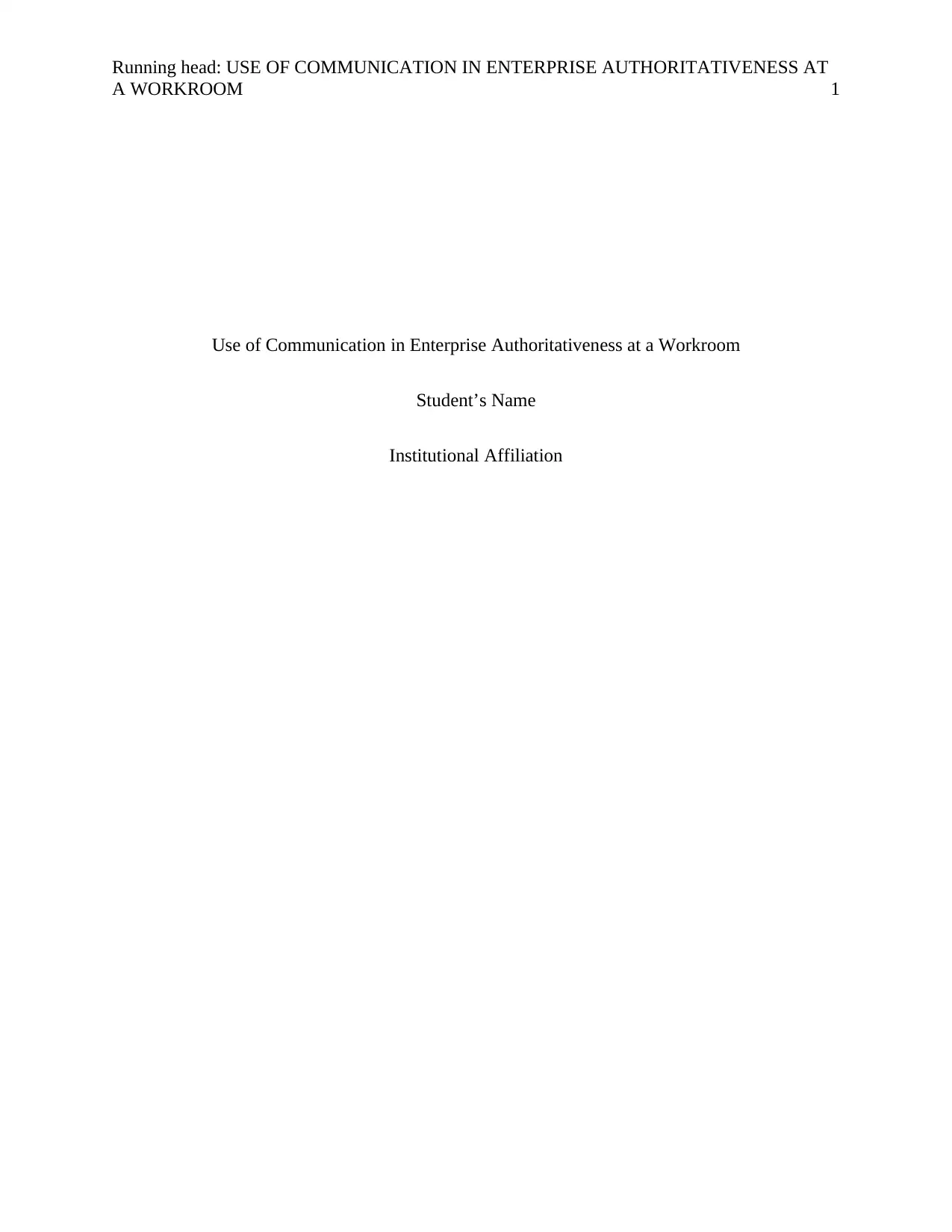
Running head: USE OF COMMUNICATION IN ENTERPRISE AUTHORITATIVENESS AT
A WORKROOM 1
Use of Communication in Enterprise Authoritativeness at a Workroom
Student’s Name
Institutional Affiliation
A WORKROOM 1
Use of Communication in Enterprise Authoritativeness at a Workroom
Student’s Name
Institutional Affiliation
Paraphrase This Document
Need a fresh take? Get an instant paraphrase of this document with our AI Paraphraser
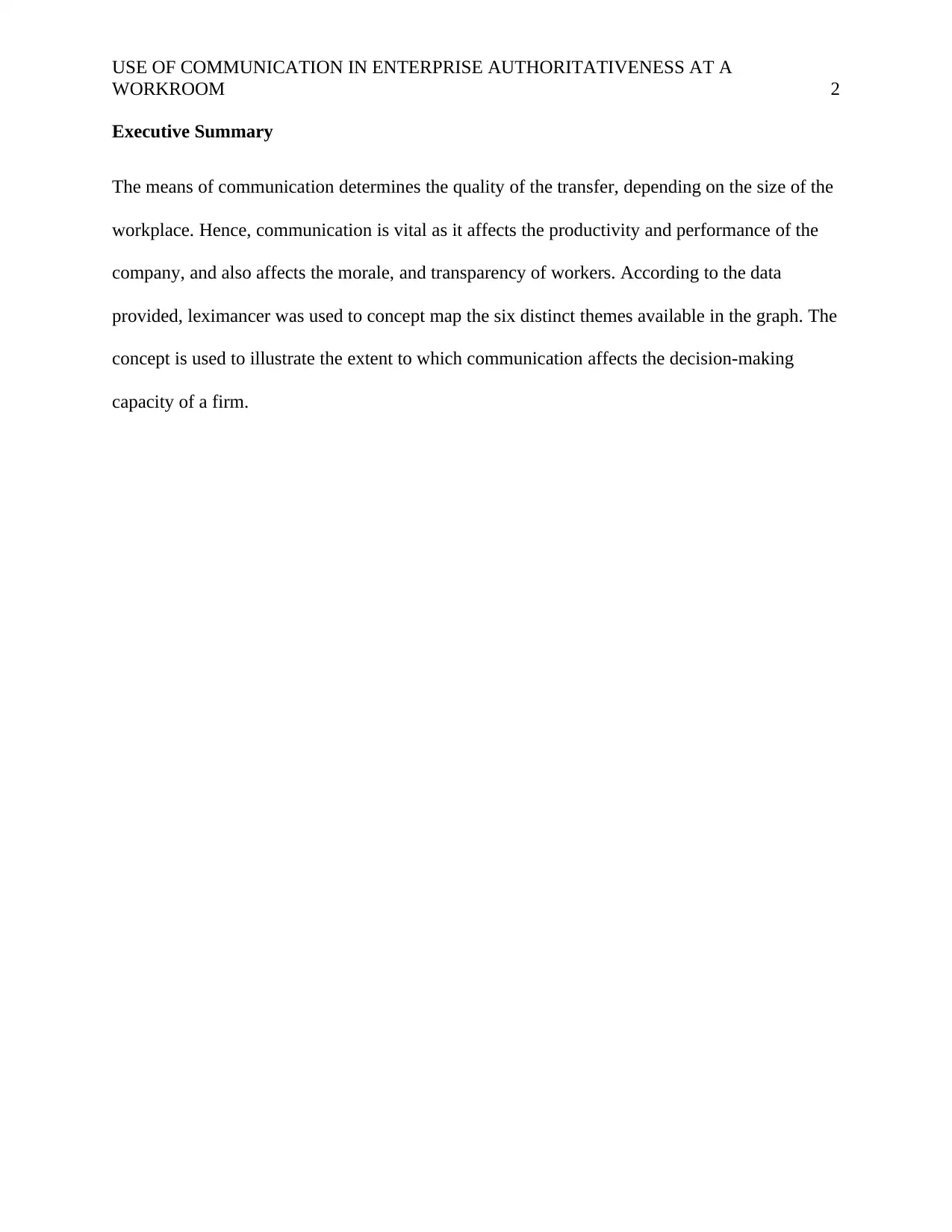
USE OF COMMUNICATION IN ENTERPRISE AUTHORITATIVENESS AT A
WORKROOM 2
Executive Summary
The means of communication determines the quality of the transfer, depending on the size of the
workplace. Hence, communication is vital as it affects the productivity and performance of the
company, and also affects the morale, and transparency of workers. According to the data
provided, leximancer was used to concept map the six distinct themes available in the graph. The
concept is used to illustrate the extent to which communication affects the decision-making
capacity of a firm.
WORKROOM 2
Executive Summary
The means of communication determines the quality of the transfer, depending on the size of the
workplace. Hence, communication is vital as it affects the productivity and performance of the
company, and also affects the morale, and transparency of workers. According to the data
provided, leximancer was used to concept map the six distinct themes available in the graph. The
concept is used to illustrate the extent to which communication affects the decision-making
capacity of a firm.
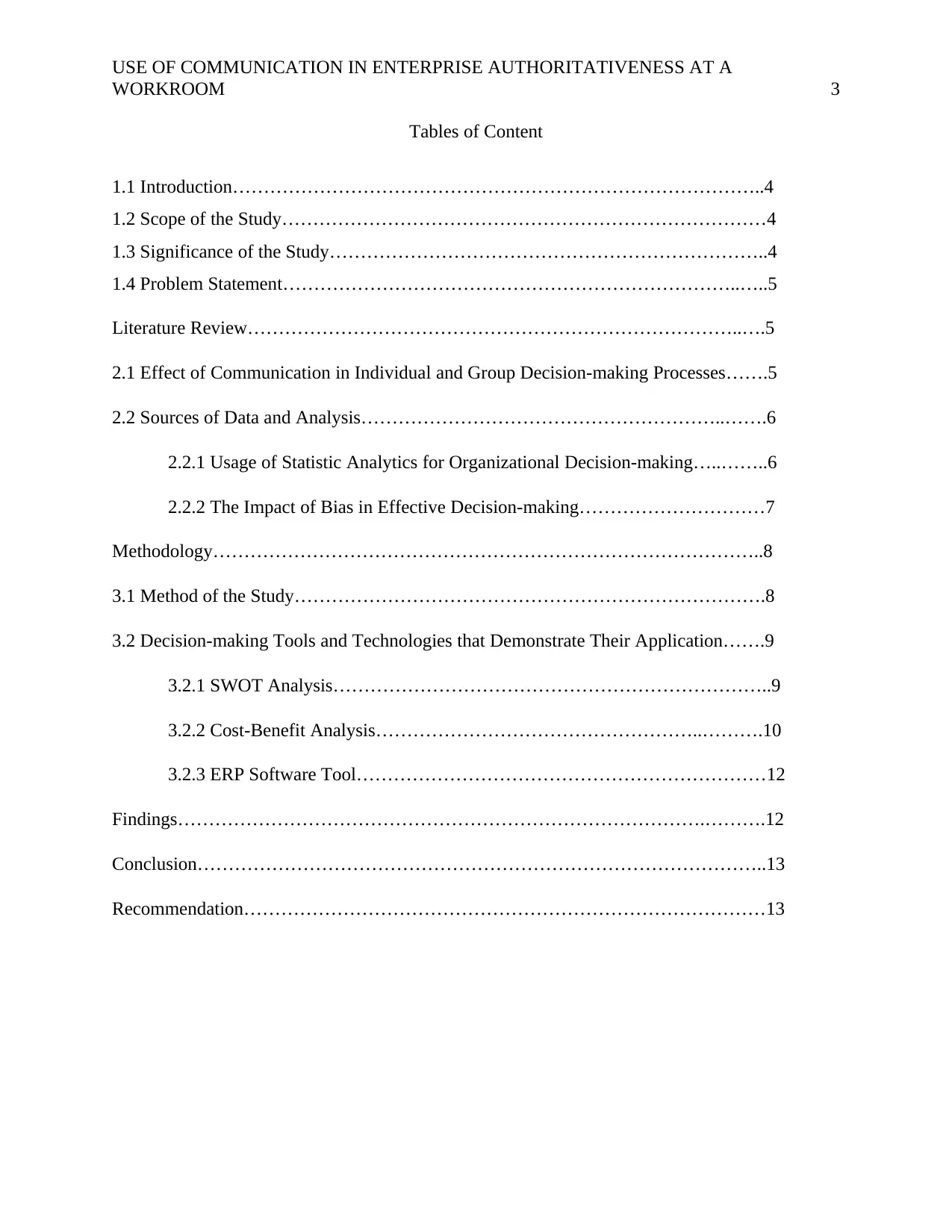
USE OF COMMUNICATION IN ENTERPRISE AUTHORITATIVENESS AT A
WORKROOM 3
Tables of Content
1.1 Introduction…………………………………………………………………………..4
1.2 Scope of the Study……………………………………………………………………4
1.3 Significance of the Study……………………………………………………………..4
1.4 Problem Statement………………………………………………………………..…..5
Literature Review……………………………………………………………………..….5
2.1 Effect of Communication in Individual and Group Decision-making Processes…….5
2.2 Sources of Data and Analysis…………………………………………………..…….6
2.2.1 Usage of Statistic Analytics for Organizational Decision-making…..……..6
2.2.2 The Impact of Bias in Effective Decision-making…………………………7
Methodology……………………………………………………………………………..8
3.1 Method of the Study………………………………………………………………….8
3.2 Decision-making Tools and Technologies that Demonstrate Their Application…….9
3.2.1 SWOT Analysis……………………………………………………………..9
3.2.2 Cost-Benefit Analysis……………………………………………..……….10
3.2.3 ERP Software Tool…………………………………………………………12
Findings………………………………………………………………………….……….12
Conclusion………………………………………………………………………………..13
Recommendation…………………………………………………………………………13
WORKROOM 3
Tables of Content
1.1 Introduction…………………………………………………………………………..4
1.2 Scope of the Study……………………………………………………………………4
1.3 Significance of the Study……………………………………………………………..4
1.4 Problem Statement………………………………………………………………..…..5
Literature Review……………………………………………………………………..….5
2.1 Effect of Communication in Individual and Group Decision-making Processes…….5
2.2 Sources of Data and Analysis…………………………………………………..…….6
2.2.1 Usage of Statistic Analytics for Organizational Decision-making…..……..6
2.2.2 The Impact of Bias in Effective Decision-making…………………………7
Methodology……………………………………………………………………………..8
3.1 Method of the Study………………………………………………………………….8
3.2 Decision-making Tools and Technologies that Demonstrate Their Application…….9
3.2.1 SWOT Analysis……………………………………………………………..9
3.2.2 Cost-Benefit Analysis……………………………………………..……….10
3.2.3 ERP Software Tool…………………………………………………………12
Findings………………………………………………………………………….……….12
Conclusion………………………………………………………………………………..13
Recommendation…………………………………………………………………………13
⊘ This is a preview!⊘
Do you want full access?
Subscribe today to unlock all pages.

Trusted by 1+ million students worldwide
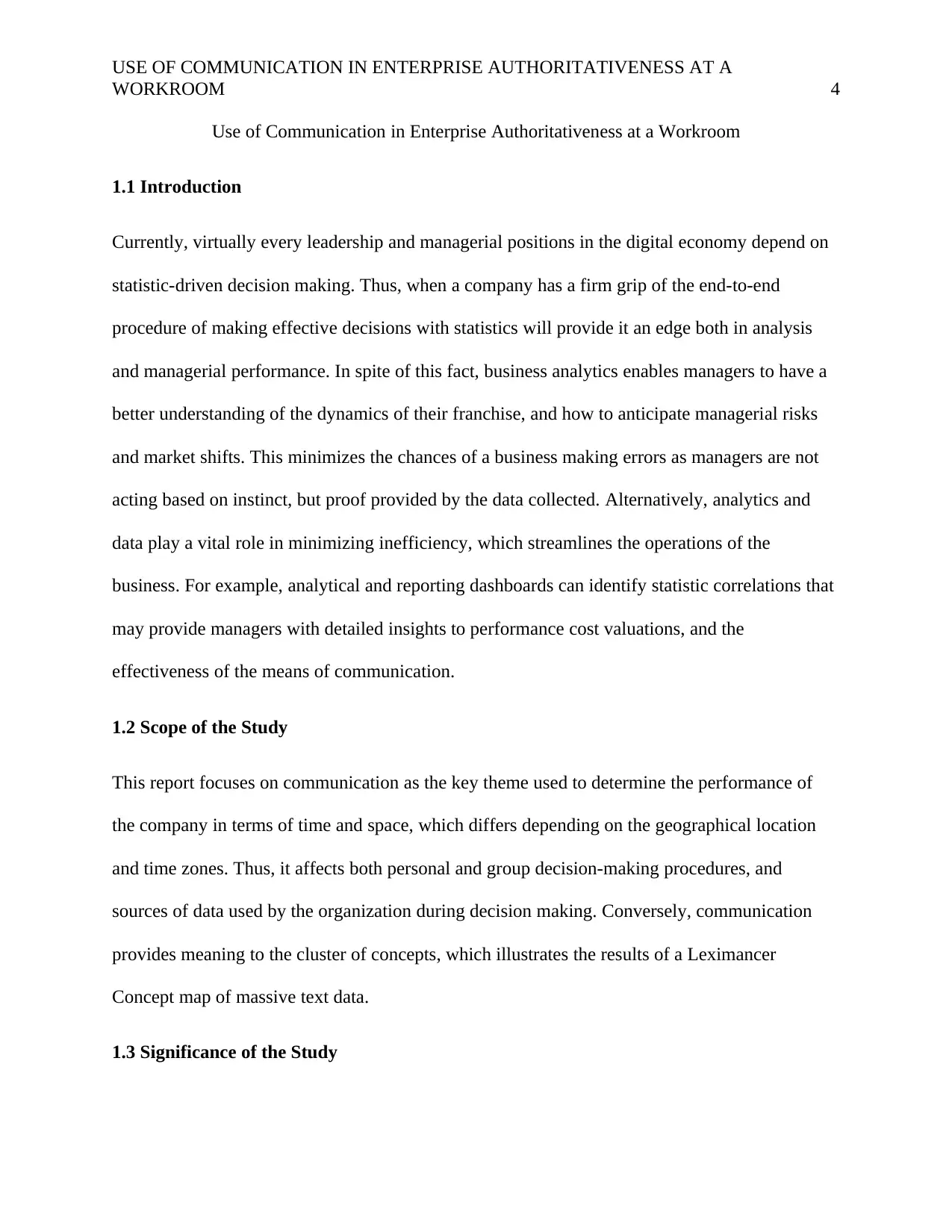
USE OF COMMUNICATION IN ENTERPRISE AUTHORITATIVENESS AT A
WORKROOM 4
Use of Communication in Enterprise Authoritativeness at a Workroom
1.1 Introduction
Currently, virtually every leadership and managerial positions in the digital economy depend on
statistic-driven decision making. Thus, when a company has a firm grip of the end-to-end
procedure of making effective decisions with statistics will provide it an edge both in analysis
and managerial performance. In spite of this fact, business analytics enables managers to have a
better understanding of the dynamics of their franchise, and how to anticipate managerial risks
and market shifts. This minimizes the chances of a business making errors as managers are not
acting based on instinct, but proof provided by the data collected. Alternatively, analytics and
data play a vital role in minimizing inefficiency, which streamlines the operations of the
business. For example, analytical and reporting dashboards can identify statistic correlations that
may provide managers with detailed insights to performance cost valuations, and the
effectiveness of the means of communication.
1.2 Scope of the Study
This report focuses on communication as the key theme used to determine the performance of
the company in terms of time and space, which differs depending on the geographical location
and time zones. Thus, it affects both personal and group decision-making procedures, and
sources of data used by the organization during decision making. Conversely, communication
provides meaning to the cluster of concepts, which illustrates the results of a Leximancer
Concept map of massive text data.
1.3 Significance of the Study
WORKROOM 4
Use of Communication in Enterprise Authoritativeness at a Workroom
1.1 Introduction
Currently, virtually every leadership and managerial positions in the digital economy depend on
statistic-driven decision making. Thus, when a company has a firm grip of the end-to-end
procedure of making effective decisions with statistics will provide it an edge both in analysis
and managerial performance. In spite of this fact, business analytics enables managers to have a
better understanding of the dynamics of their franchise, and how to anticipate managerial risks
and market shifts. This minimizes the chances of a business making errors as managers are not
acting based on instinct, but proof provided by the data collected. Alternatively, analytics and
data play a vital role in minimizing inefficiency, which streamlines the operations of the
business. For example, analytical and reporting dashboards can identify statistic correlations that
may provide managers with detailed insights to performance cost valuations, and the
effectiveness of the means of communication.
1.2 Scope of the Study
This report focuses on communication as the key theme used to determine the performance of
the company in terms of time and space, which differs depending on the geographical location
and time zones. Thus, it affects both personal and group decision-making procedures, and
sources of data used by the organization during decision making. Conversely, communication
provides meaning to the cluster of concepts, which illustrates the results of a Leximancer
Concept map of massive text data.
1.3 Significance of the Study
Paraphrase This Document
Need a fresh take? Get an instant paraphrase of this document with our AI Paraphraser
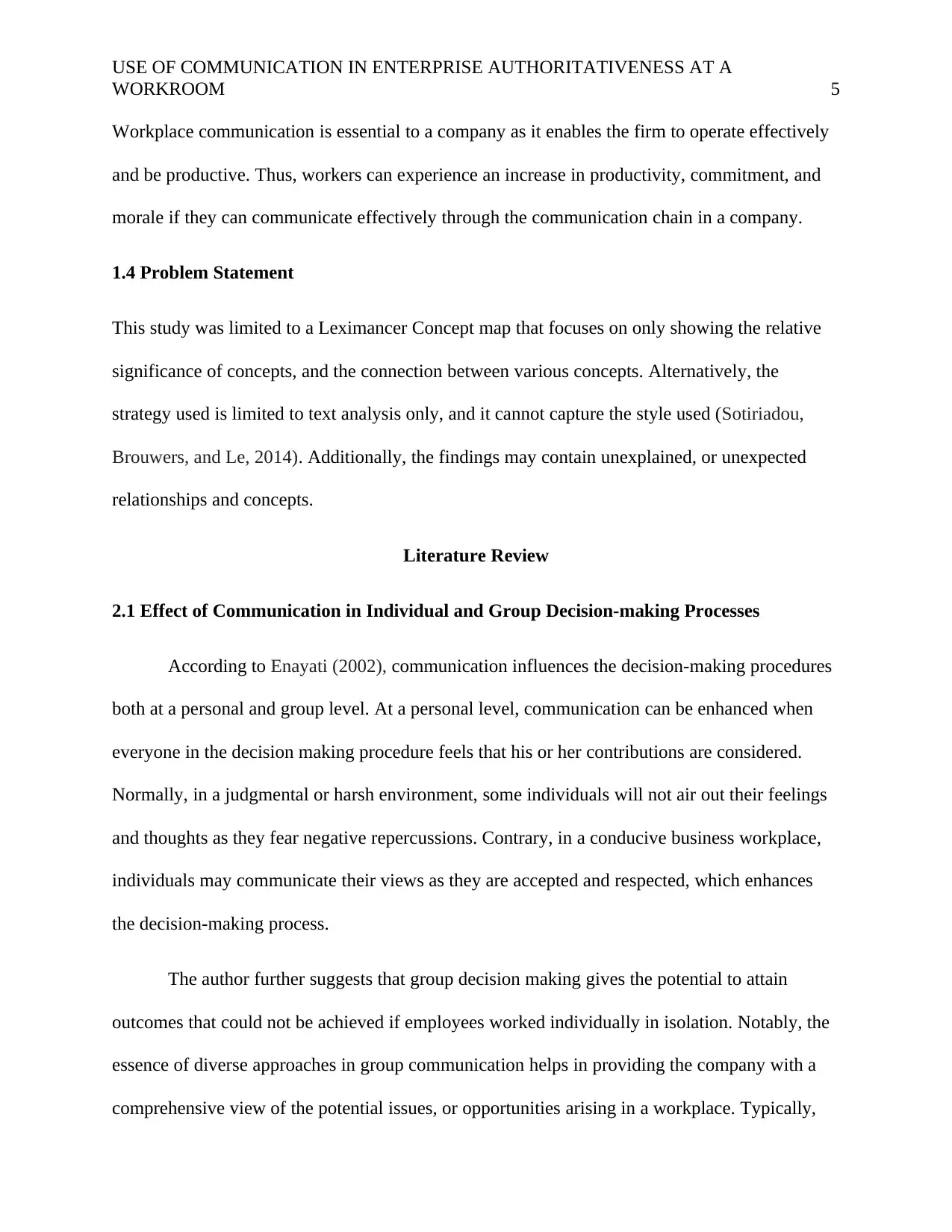
USE OF COMMUNICATION IN ENTERPRISE AUTHORITATIVENESS AT A
WORKROOM 5
Workplace communication is essential to a company as it enables the firm to operate effectively
and be productive. Thus, workers can experience an increase in productivity, commitment, and
morale if they can communicate effectively through the communication chain in a company.
1.4 Problem Statement
This study was limited to a Leximancer Concept map that focuses on only showing the relative
significance of concepts, and the connection between various concepts. Alternatively, the
strategy used is limited to text analysis only, and it cannot capture the style used (Sotiriadou,
Brouwers, and Le, 2014). Additionally, the findings may contain unexplained, or unexpected
relationships and concepts.
Literature Review
2.1 Effect of Communication in Individual and Group Decision-making Processes
According to Enayati (2002), communication influences the decision-making procedures
both at a personal and group level. At a personal level, communication can be enhanced when
everyone in the decision making procedure feels that his or her contributions are considered.
Normally, in a judgmental or harsh environment, some individuals will not air out their feelings
and thoughts as they fear negative repercussions. Contrary, in a conducive business workplace,
individuals may communicate their views as they are accepted and respected, which enhances
the decision-making process.
The author further suggests that group decision making gives the potential to attain
outcomes that could not be achieved if employees worked individually in isolation. Notably, the
essence of diverse approaches in group communication helps in providing the company with a
comprehensive view of the potential issues, or opportunities arising in a workplace. Typically,
WORKROOM 5
Workplace communication is essential to a company as it enables the firm to operate effectively
and be productive. Thus, workers can experience an increase in productivity, commitment, and
morale if they can communicate effectively through the communication chain in a company.
1.4 Problem Statement
This study was limited to a Leximancer Concept map that focuses on only showing the relative
significance of concepts, and the connection between various concepts. Alternatively, the
strategy used is limited to text analysis only, and it cannot capture the style used (Sotiriadou,
Brouwers, and Le, 2014). Additionally, the findings may contain unexplained, or unexpected
relationships and concepts.
Literature Review
2.1 Effect of Communication in Individual and Group Decision-making Processes
According to Enayati (2002), communication influences the decision-making procedures
both at a personal and group level. At a personal level, communication can be enhanced when
everyone in the decision making procedure feels that his or her contributions are considered.
Normally, in a judgmental or harsh environment, some individuals will not air out their feelings
and thoughts as they fear negative repercussions. Contrary, in a conducive business workplace,
individuals may communicate their views as they are accepted and respected, which enhances
the decision-making process.
The author further suggests that group decision making gives the potential to attain
outcomes that could not be achieved if employees worked individually in isolation. Notably, the
essence of diverse approaches in group communication helps in providing the company with a
comprehensive view of the potential issues, or opportunities arising in a workplace. Typically,
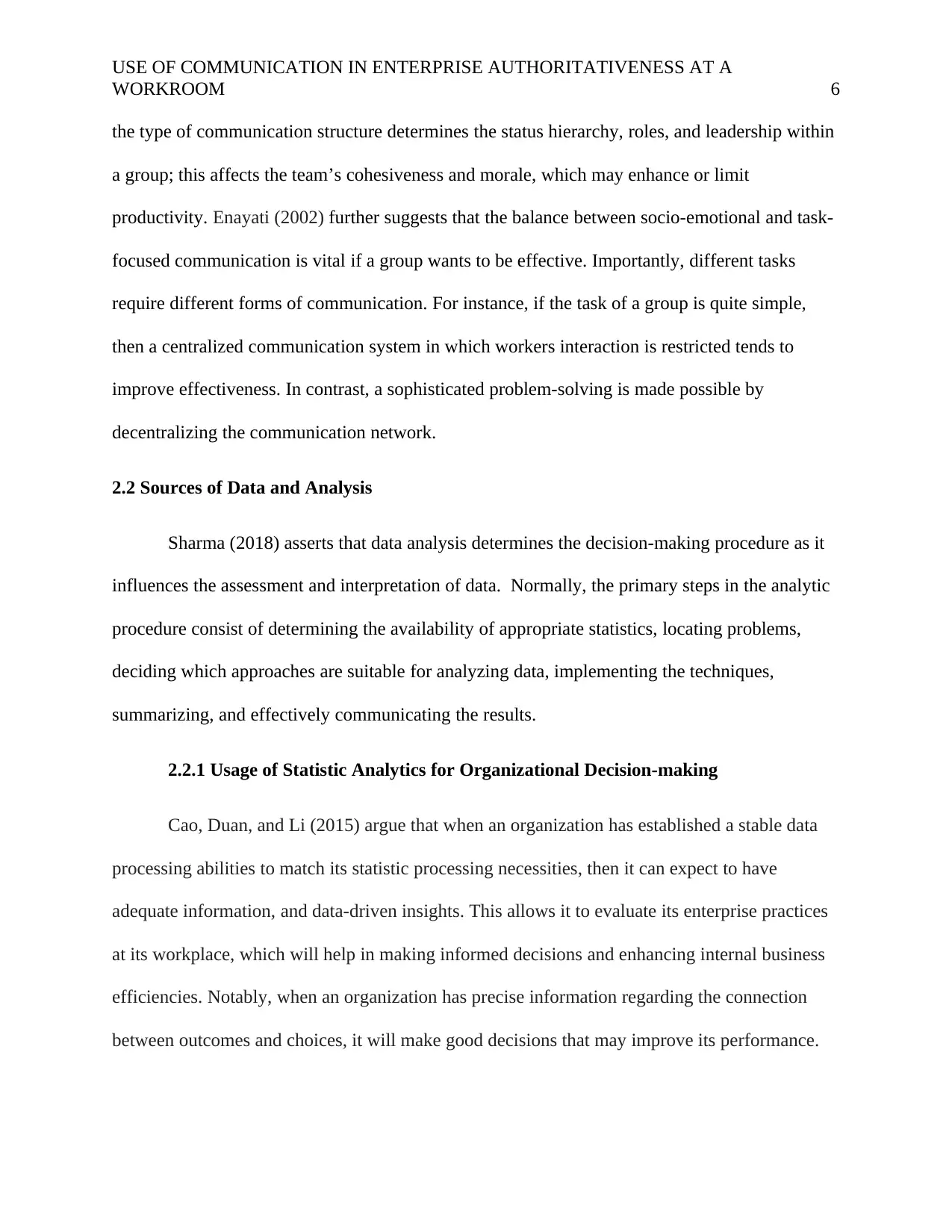
USE OF COMMUNICATION IN ENTERPRISE AUTHORITATIVENESS AT A
WORKROOM 6
the type of communication structure determines the status hierarchy, roles, and leadership within
a group; this affects the team’s cohesiveness and morale, which may enhance or limit
productivity. Enayati (2002) further suggests that the balance between socio-emotional and task-
focused communication is vital if a group wants to be effective. Importantly, different tasks
require different forms of communication. For instance, if the task of a group is quite simple,
then a centralized communication system in which workers interaction is restricted tends to
improve effectiveness. In contrast, a sophisticated problem-solving is made possible by
decentralizing the communication network.
2.2 Sources of Data and Analysis
Sharma (2018) asserts that data analysis determines the decision-making procedure as it
influences the assessment and interpretation of data. Normally, the primary steps in the analytic
procedure consist of determining the availability of appropriate statistics, locating problems,
deciding which approaches are suitable for analyzing data, implementing the techniques,
summarizing, and effectively communicating the results.
2.2.1 Usage of Statistic Analytics for Organizational Decision-making
Cao, Duan, and Li (2015) argue that when an organization has established a stable data
processing abilities to match its statistic processing necessities, then it can expect to have
adequate information, and data-driven insights. This allows it to evaluate its enterprise practices
at its workplace, which will help in making informed decisions and enhancing internal business
efficiencies. Notably, when an organization has precise information regarding the connection
between outcomes and choices, it will make good decisions that may improve its performance.
WORKROOM 6
the type of communication structure determines the status hierarchy, roles, and leadership within
a group; this affects the team’s cohesiveness and morale, which may enhance or limit
productivity. Enayati (2002) further suggests that the balance between socio-emotional and task-
focused communication is vital if a group wants to be effective. Importantly, different tasks
require different forms of communication. For instance, if the task of a group is quite simple,
then a centralized communication system in which workers interaction is restricted tends to
improve effectiveness. In contrast, a sophisticated problem-solving is made possible by
decentralizing the communication network.
2.2 Sources of Data and Analysis
Sharma (2018) asserts that data analysis determines the decision-making procedure as it
influences the assessment and interpretation of data. Normally, the primary steps in the analytic
procedure consist of determining the availability of appropriate statistics, locating problems,
deciding which approaches are suitable for analyzing data, implementing the techniques,
summarizing, and effectively communicating the results.
2.2.1 Usage of Statistic Analytics for Organizational Decision-making
Cao, Duan, and Li (2015) argue that when an organization has established a stable data
processing abilities to match its statistic processing necessities, then it can expect to have
adequate information, and data-driven insights. This allows it to evaluate its enterprise practices
at its workplace, which will help in making informed decisions and enhancing internal business
efficiencies. Notably, when an organization has precise information regarding the connection
between outcomes and choices, it will make good decisions that may improve its performance.
⊘ This is a preview!⊘
Do you want full access?
Subscribe today to unlock all pages.

Trusted by 1+ million students worldwide
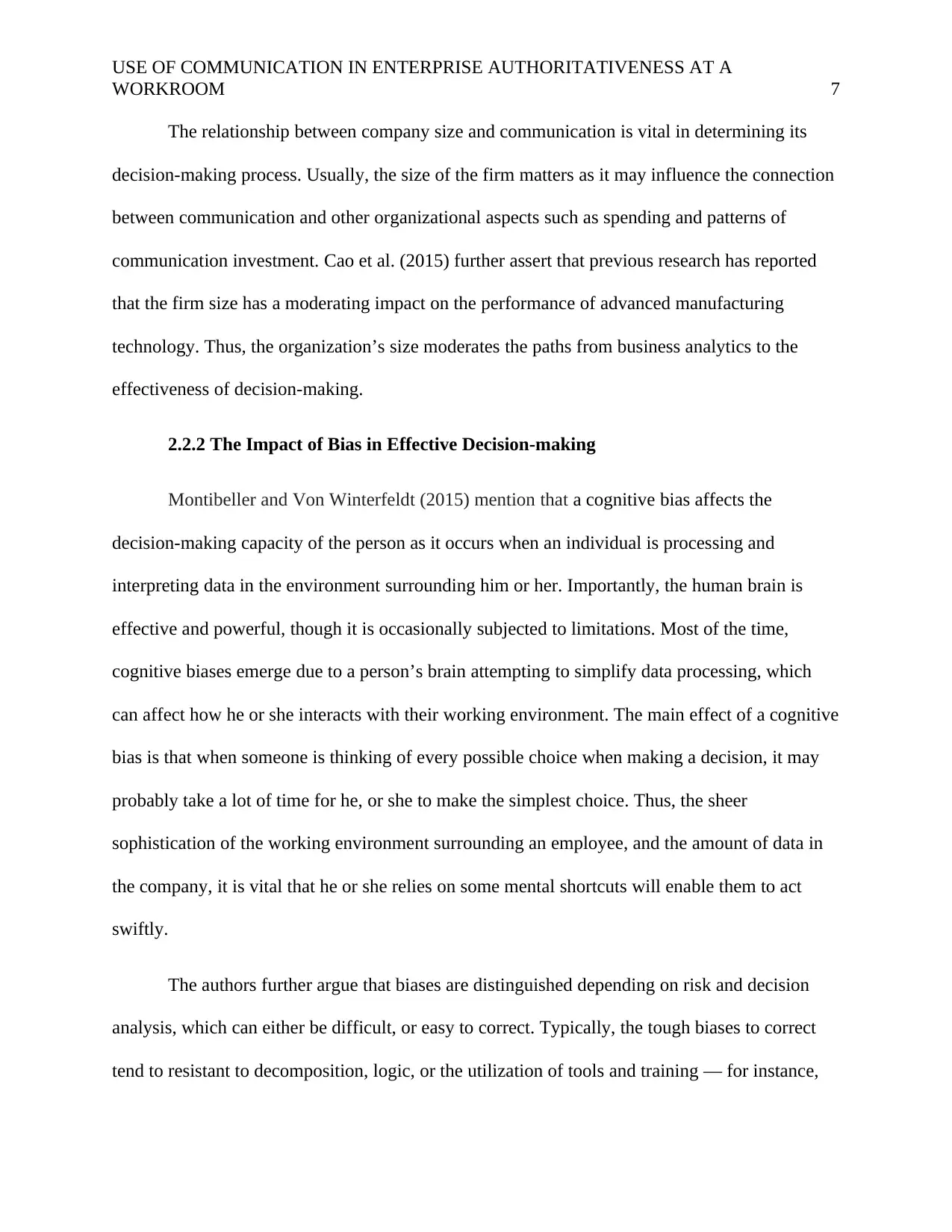
USE OF COMMUNICATION IN ENTERPRISE AUTHORITATIVENESS AT A
WORKROOM 7
The relationship between company size and communication is vital in determining its
decision-making process. Usually, the size of the firm matters as it may influence the connection
between communication and other organizational aspects such as spending and patterns of
communication investment. Cao et al. (2015) further assert that previous research has reported
that the firm size has a moderating impact on the performance of advanced manufacturing
technology. Thus, the organization’s size moderates the paths from business analytics to the
effectiveness of decision-making.
2.2.2 The Impact of Bias in Effective Decision-making
Montibeller and Von Winterfeldt (2015) mention that a cognitive bias affects the
decision-making capacity of the person as it occurs when an individual is processing and
interpreting data in the environment surrounding him or her. Importantly, the human brain is
effective and powerful, though it is occasionally subjected to limitations. Most of the time,
cognitive biases emerge due to a person’s brain attempting to simplify data processing, which
can affect how he or she interacts with their working environment. The main effect of a cognitive
bias is that when someone is thinking of every possible choice when making a decision, it may
probably take a lot of time for he, or she to make the simplest choice. Thus, the sheer
sophistication of the working environment surrounding an employee, and the amount of data in
the company, it is vital that he or she relies on some mental shortcuts will enable them to act
swiftly.
The authors further argue that biases are distinguished depending on risk and decision
analysis, which can either be difficult, or easy to correct. Typically, the tough biases to correct
tend to resistant to decomposition, logic, or the utilization of tools and training — for instance,
WORKROOM 7
The relationship between company size and communication is vital in determining its
decision-making process. Usually, the size of the firm matters as it may influence the connection
between communication and other organizational aspects such as spending and patterns of
communication investment. Cao et al. (2015) further assert that previous research has reported
that the firm size has a moderating impact on the performance of advanced manufacturing
technology. Thus, the organization’s size moderates the paths from business analytics to the
effectiveness of decision-making.
2.2.2 The Impact of Bias in Effective Decision-making
Montibeller and Von Winterfeldt (2015) mention that a cognitive bias affects the
decision-making capacity of the person as it occurs when an individual is processing and
interpreting data in the environment surrounding him or her. Importantly, the human brain is
effective and powerful, though it is occasionally subjected to limitations. Most of the time,
cognitive biases emerge due to a person’s brain attempting to simplify data processing, which
can affect how he or she interacts with their working environment. The main effect of a cognitive
bias is that when someone is thinking of every possible choice when making a decision, it may
probably take a lot of time for he, or she to make the simplest choice. Thus, the sheer
sophistication of the working environment surrounding an employee, and the amount of data in
the company, it is vital that he or she relies on some mental shortcuts will enable them to act
swiftly.
The authors further argue that biases are distinguished depending on risk and decision
analysis, which can either be difficult, or easy to correct. Typically, the tough biases to correct
tend to resistant to decomposition, logic, or the utilization of tools and training — for instance,
Paraphrase This Document
Need a fresh take? Get an instant paraphrase of this document with our AI Paraphraser
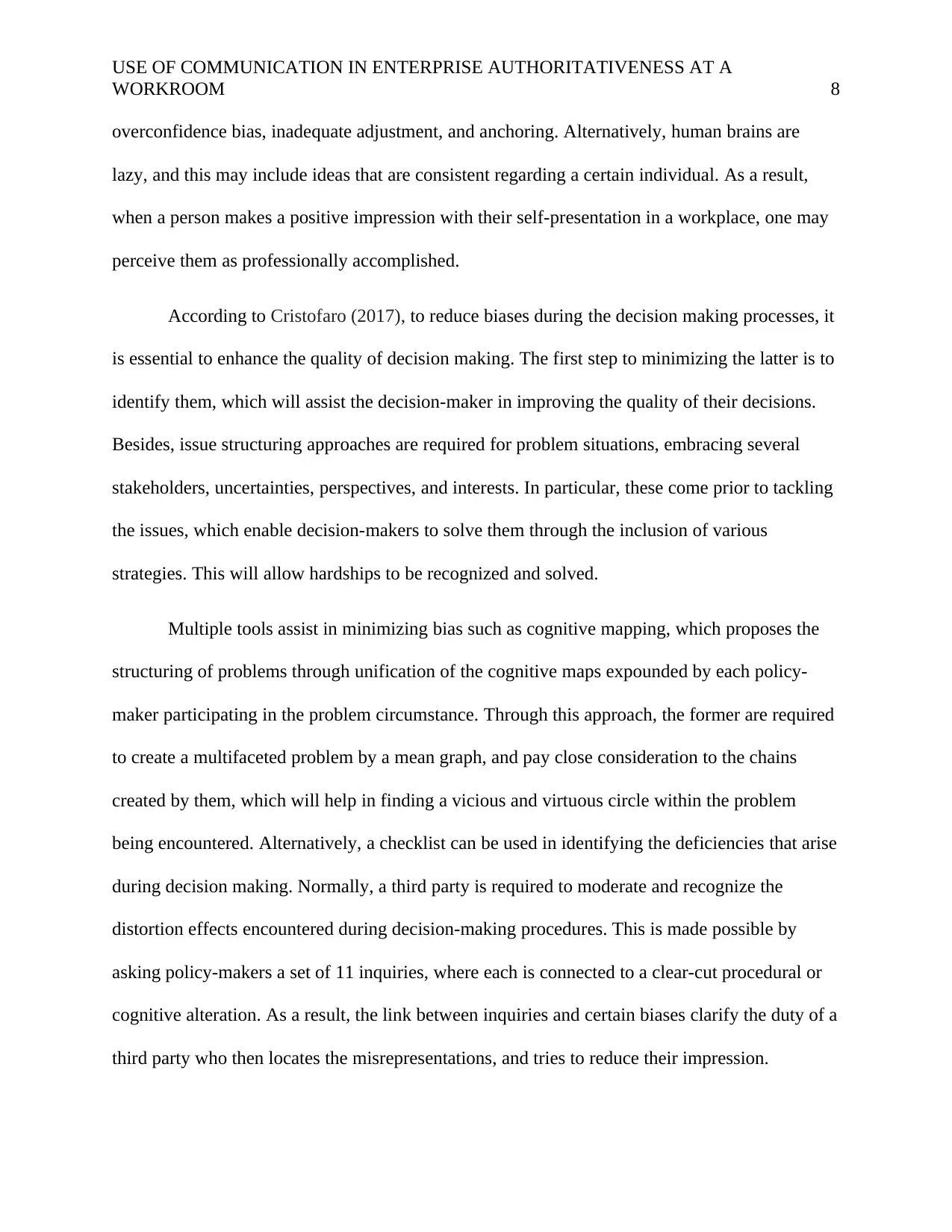
USE OF COMMUNICATION IN ENTERPRISE AUTHORITATIVENESS AT A
WORKROOM 8
overconfidence bias, inadequate adjustment, and anchoring. Alternatively, human brains are
lazy, and this may include ideas that are consistent regarding a certain individual. As a result,
when a person makes a positive impression with their self-presentation in a workplace, one may
perceive them as professionally accomplished.
According to Cristofaro (2017), to reduce biases during the decision making processes, it
is essential to enhance the quality of decision making. The first step to minimizing the latter is to
identify them, which will assist the decision-maker in improving the quality of their decisions.
Besides, issue structuring approaches are required for problem situations, embracing several
stakeholders, uncertainties, perspectives, and interests. In particular, these come prior to tackling
the issues, which enable decision-makers to solve them through the inclusion of various
strategies. This will allow hardships to be recognized and solved.
Multiple tools assist in minimizing bias such as cognitive mapping, which proposes the
structuring of problems through unification of the cognitive maps expounded by each policy-
maker participating in the problem circumstance. Through this approach, the former are required
to create a multifaceted problem by a mean graph, and pay close consideration to the chains
created by them, which will help in finding a vicious and virtuous circle within the problem
being encountered. Alternatively, a checklist can be used in identifying the deficiencies that arise
during decision making. Normally, a third party is required to moderate and recognize the
distortion effects encountered during decision-making procedures. This is made possible by
asking policy-makers a set of 11 inquiries, where each is connected to a clear-cut procedural or
cognitive alteration. As a result, the link between inquiries and certain biases clarify the duty of a
third party who then locates the misrepresentations, and tries to reduce their impression.
WORKROOM 8
overconfidence bias, inadequate adjustment, and anchoring. Alternatively, human brains are
lazy, and this may include ideas that are consistent regarding a certain individual. As a result,
when a person makes a positive impression with their self-presentation in a workplace, one may
perceive them as professionally accomplished.
According to Cristofaro (2017), to reduce biases during the decision making processes, it
is essential to enhance the quality of decision making. The first step to minimizing the latter is to
identify them, which will assist the decision-maker in improving the quality of their decisions.
Besides, issue structuring approaches are required for problem situations, embracing several
stakeholders, uncertainties, perspectives, and interests. In particular, these come prior to tackling
the issues, which enable decision-makers to solve them through the inclusion of various
strategies. This will allow hardships to be recognized and solved.
Multiple tools assist in minimizing bias such as cognitive mapping, which proposes the
structuring of problems through unification of the cognitive maps expounded by each policy-
maker participating in the problem circumstance. Through this approach, the former are required
to create a multifaceted problem by a mean graph, and pay close consideration to the chains
created by them, which will help in finding a vicious and virtuous circle within the problem
being encountered. Alternatively, a checklist can be used in identifying the deficiencies that arise
during decision making. Normally, a third party is required to moderate and recognize the
distortion effects encountered during decision-making procedures. This is made possible by
asking policy-makers a set of 11 inquiries, where each is connected to a clear-cut procedural or
cognitive alteration. As a result, the link between inquiries and certain biases clarify the duty of a
third party who then locates the misrepresentations, and tries to reduce their impression.
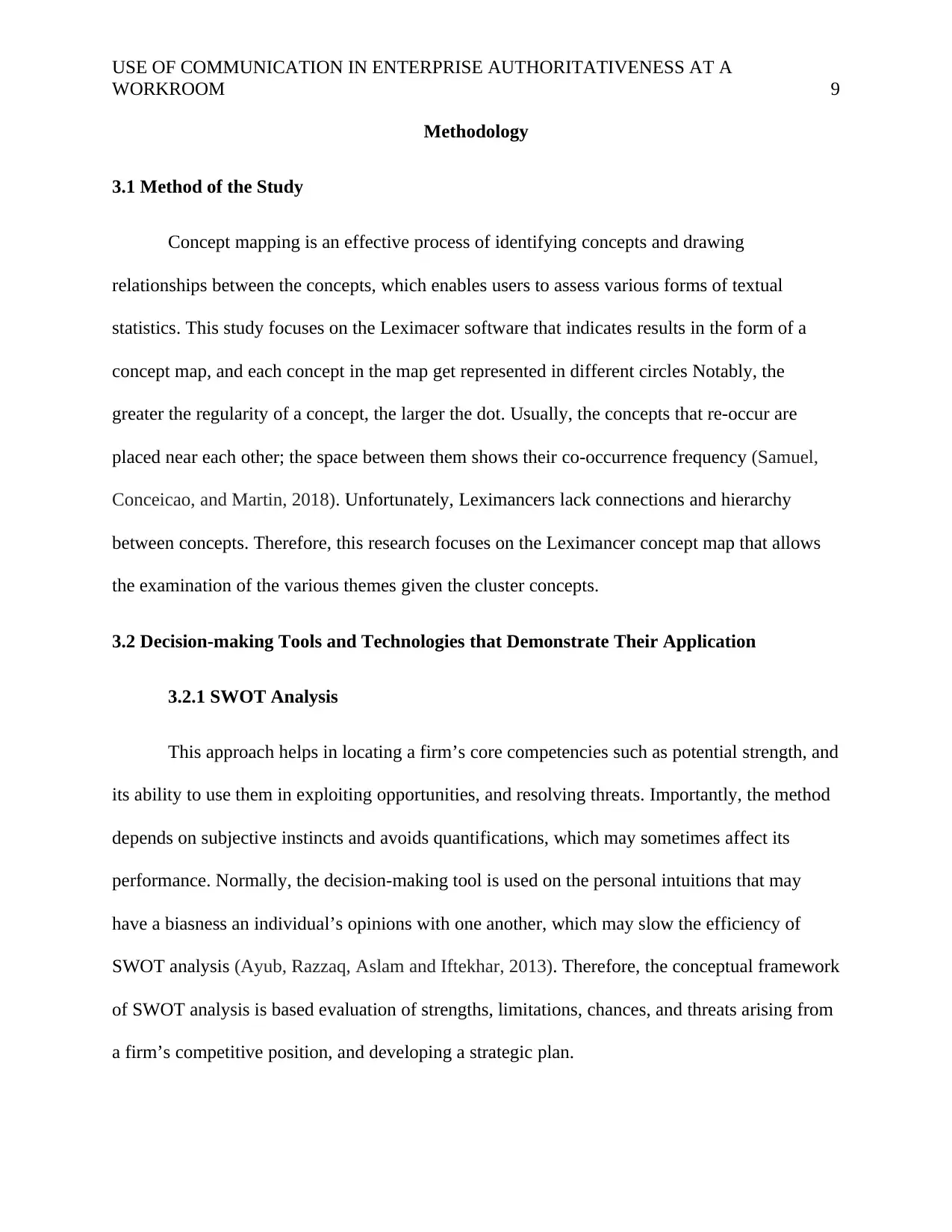
USE OF COMMUNICATION IN ENTERPRISE AUTHORITATIVENESS AT A
WORKROOM 9
Methodology
3.1 Method of the Study
Concept mapping is an effective process of identifying concepts and drawing
relationships between the concepts, which enables users to assess various forms of textual
statistics. This study focuses on the Leximacer software that indicates results in the form of a
concept map, and each concept in the map get represented in different circles Notably, the
greater the regularity of a concept, the larger the dot. Usually, the concepts that re-occur are
placed near each other; the space between them shows their co-occurrence frequency (Samuel,
Conceicao, and Martin, 2018). Unfortunately, Leximancers lack connections and hierarchy
between concepts. Therefore, this research focuses on the Leximancer concept map that allows
the examination of the various themes given the cluster concepts.
3.2 Decision-making Tools and Technologies that Demonstrate Their Application
3.2.1 SWOT Analysis
This approach helps in locating a firm’s core competencies such as potential strength, and
its ability to use them in exploiting opportunities, and resolving threats. Importantly, the method
depends on subjective instincts and avoids quantifications, which may sometimes affect its
performance. Normally, the decision-making tool is used on the personal intuitions that may
have a biasness an individual’s opinions with one another, which may slow the efficiency of
SWOT analysis (Ayub, Razzaq, Aslam and Iftekhar, 2013). Therefore, the conceptual framework
of SWOT analysis is based evaluation of strengths, limitations, chances, and threats arising from
a firm’s competitive position, and developing a strategic plan.
WORKROOM 9
Methodology
3.1 Method of the Study
Concept mapping is an effective process of identifying concepts and drawing
relationships between the concepts, which enables users to assess various forms of textual
statistics. This study focuses on the Leximacer software that indicates results in the form of a
concept map, and each concept in the map get represented in different circles Notably, the
greater the regularity of a concept, the larger the dot. Usually, the concepts that re-occur are
placed near each other; the space between them shows their co-occurrence frequency (Samuel,
Conceicao, and Martin, 2018). Unfortunately, Leximancers lack connections and hierarchy
between concepts. Therefore, this research focuses on the Leximancer concept map that allows
the examination of the various themes given the cluster concepts.
3.2 Decision-making Tools and Technologies that Demonstrate Their Application
3.2.1 SWOT Analysis
This approach helps in locating a firm’s core competencies such as potential strength, and
its ability to use them in exploiting opportunities, and resolving threats. Importantly, the method
depends on subjective instincts and avoids quantifications, which may sometimes affect its
performance. Normally, the decision-making tool is used on the personal intuitions that may
have a biasness an individual’s opinions with one another, which may slow the efficiency of
SWOT analysis (Ayub, Razzaq, Aslam and Iftekhar, 2013). Therefore, the conceptual framework
of SWOT analysis is based evaluation of strengths, limitations, chances, and threats arising from
a firm’s competitive position, and developing a strategic plan.
⊘ This is a preview!⊘
Do you want full access?
Subscribe today to unlock all pages.

Trusted by 1+ million students worldwide
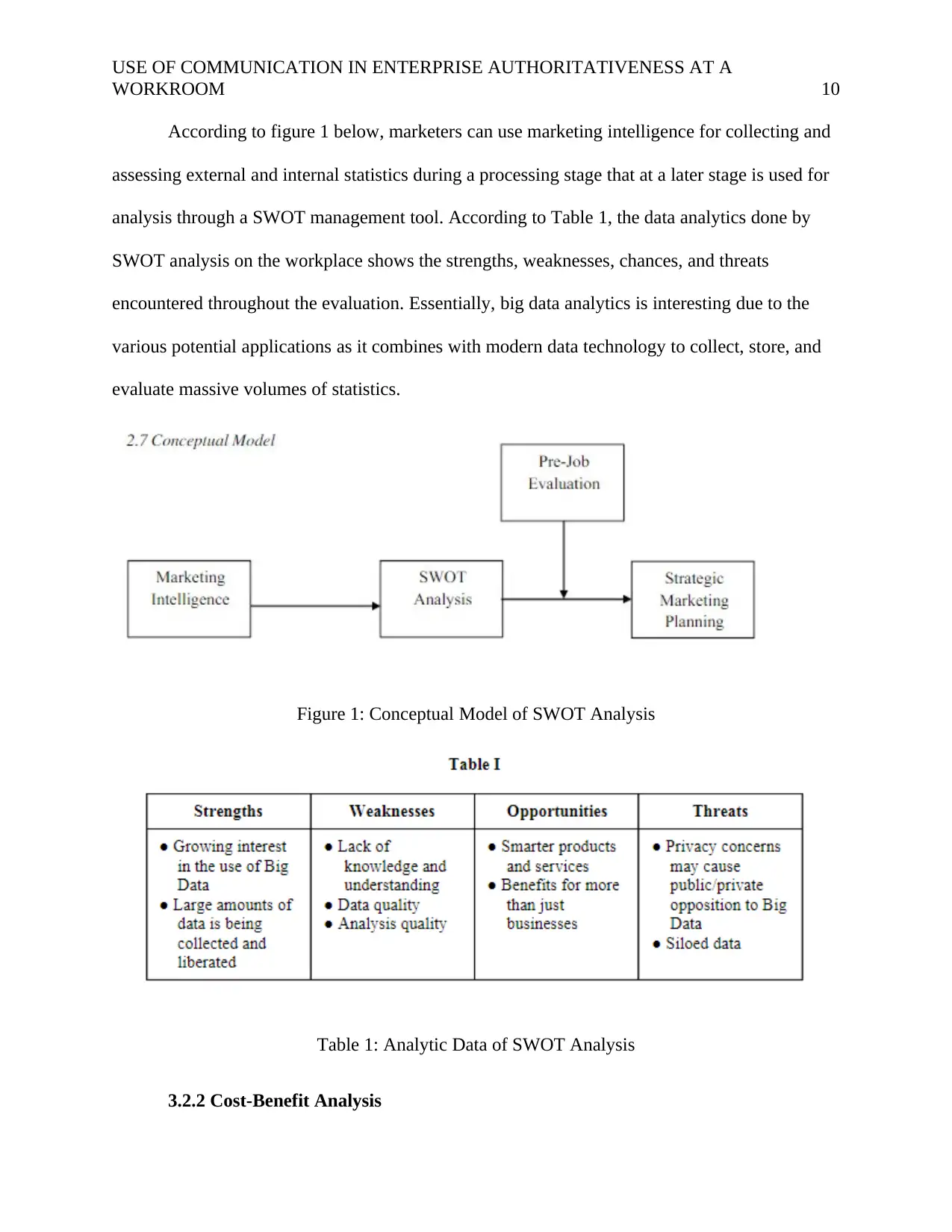
USE OF COMMUNICATION IN ENTERPRISE AUTHORITATIVENESS AT A
WORKROOM 10
According to figure 1 below, marketers can use marketing intelligence for collecting and
assessing external and internal statistics during a processing stage that at a later stage is used for
analysis through a SWOT management tool. According to Table 1, the data analytics done by
SWOT analysis on the workplace shows the strengths, weaknesses, chances, and threats
encountered throughout the evaluation. Essentially, big data analytics is interesting due to the
various potential applications as it combines with modern data technology to collect, store, and
evaluate massive volumes of statistics.
Figure 1: Conceptual Model of SWOT Analysis
Table 1: Analytic Data of SWOT Analysis
3.2.2 Cost-Benefit Analysis
WORKROOM 10
According to figure 1 below, marketers can use marketing intelligence for collecting and
assessing external and internal statistics during a processing stage that at a later stage is used for
analysis through a SWOT management tool. According to Table 1, the data analytics done by
SWOT analysis on the workplace shows the strengths, weaknesses, chances, and threats
encountered throughout the evaluation. Essentially, big data analytics is interesting due to the
various potential applications as it combines with modern data technology to collect, store, and
evaluate massive volumes of statistics.
Figure 1: Conceptual Model of SWOT Analysis
Table 1: Analytic Data of SWOT Analysis
3.2.2 Cost-Benefit Analysis
Paraphrase This Document
Need a fresh take? Get an instant paraphrase of this document with our AI Paraphraser
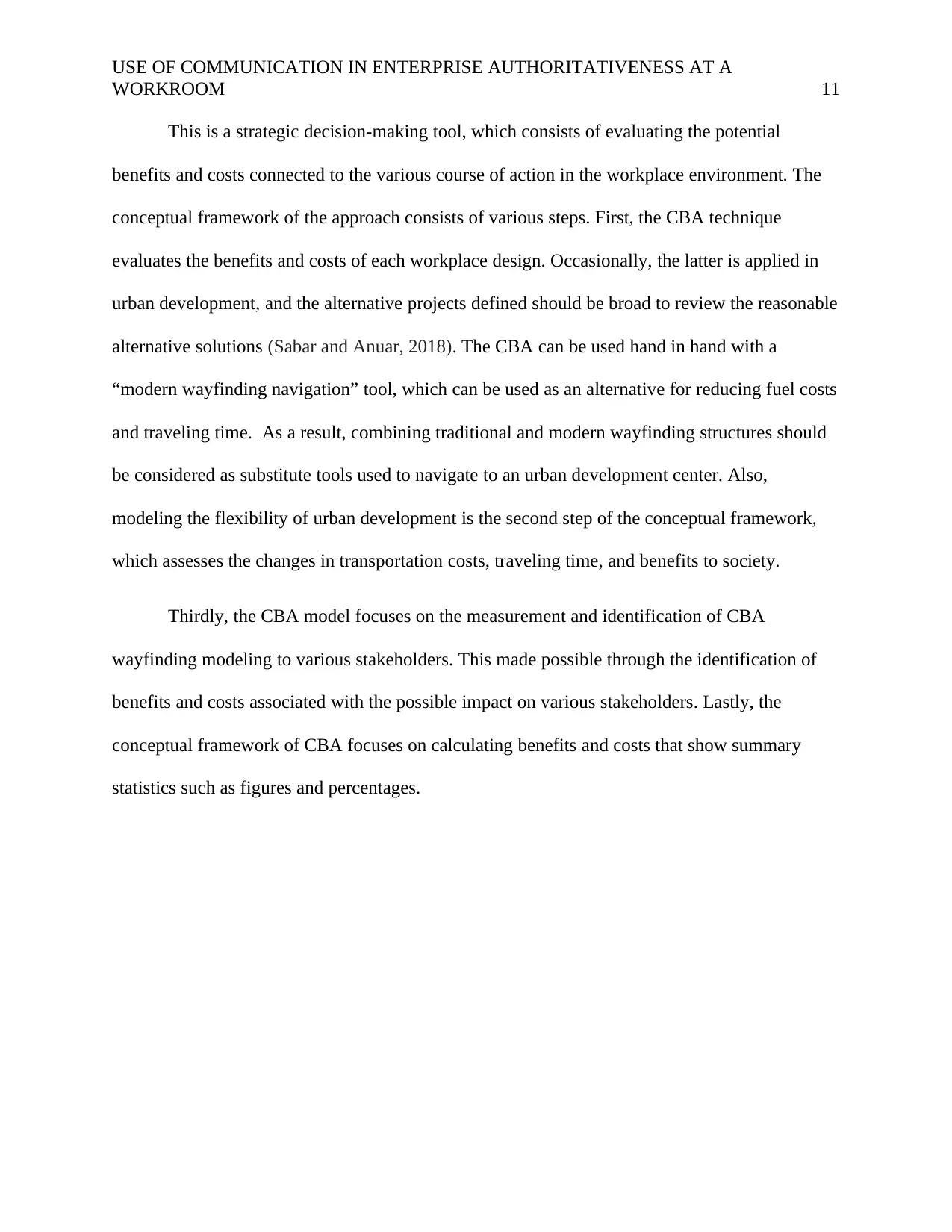
USE OF COMMUNICATION IN ENTERPRISE AUTHORITATIVENESS AT A
WORKROOM 11
This is a strategic decision-making tool, which consists of evaluating the potential
benefits and costs connected to the various course of action in the workplace environment. The
conceptual framework of the approach consists of various steps. First, the CBA technique
evaluates the benefits and costs of each workplace design. Occasionally, the latter is applied in
urban development, and the alternative projects defined should be broad to review the reasonable
alternative solutions (Sabar and Anuar, 2018). The CBA can be used hand in hand with a
“modern wayfinding navigation” tool, which can be used as an alternative for reducing fuel costs
and traveling time. As a result, combining traditional and modern wayfinding structures should
be considered as substitute tools used to navigate to an urban development center. Also,
modeling the flexibility of urban development is the second step of the conceptual framework,
which assesses the changes in transportation costs, traveling time, and benefits to society.
Thirdly, the CBA model focuses on the measurement and identification of CBA
wayfinding modeling to various stakeholders. This made possible through the identification of
benefits and costs associated with the possible impact on various stakeholders. Lastly, the
conceptual framework of CBA focuses on calculating benefits and costs that show summary
statistics such as figures and percentages.
WORKROOM 11
This is a strategic decision-making tool, which consists of evaluating the potential
benefits and costs connected to the various course of action in the workplace environment. The
conceptual framework of the approach consists of various steps. First, the CBA technique
evaluates the benefits and costs of each workplace design. Occasionally, the latter is applied in
urban development, and the alternative projects defined should be broad to review the reasonable
alternative solutions (Sabar and Anuar, 2018). The CBA can be used hand in hand with a
“modern wayfinding navigation” tool, which can be used as an alternative for reducing fuel costs
and traveling time. As a result, combining traditional and modern wayfinding structures should
be considered as substitute tools used to navigate to an urban development center. Also,
modeling the flexibility of urban development is the second step of the conceptual framework,
which assesses the changes in transportation costs, traveling time, and benefits to society.
Thirdly, the CBA model focuses on the measurement and identification of CBA
wayfinding modeling to various stakeholders. This made possible through the identification of
benefits and costs associated with the possible impact on various stakeholders. Lastly, the
conceptual framework of CBA focuses on calculating benefits and costs that show summary
statistics such as figures and percentages.
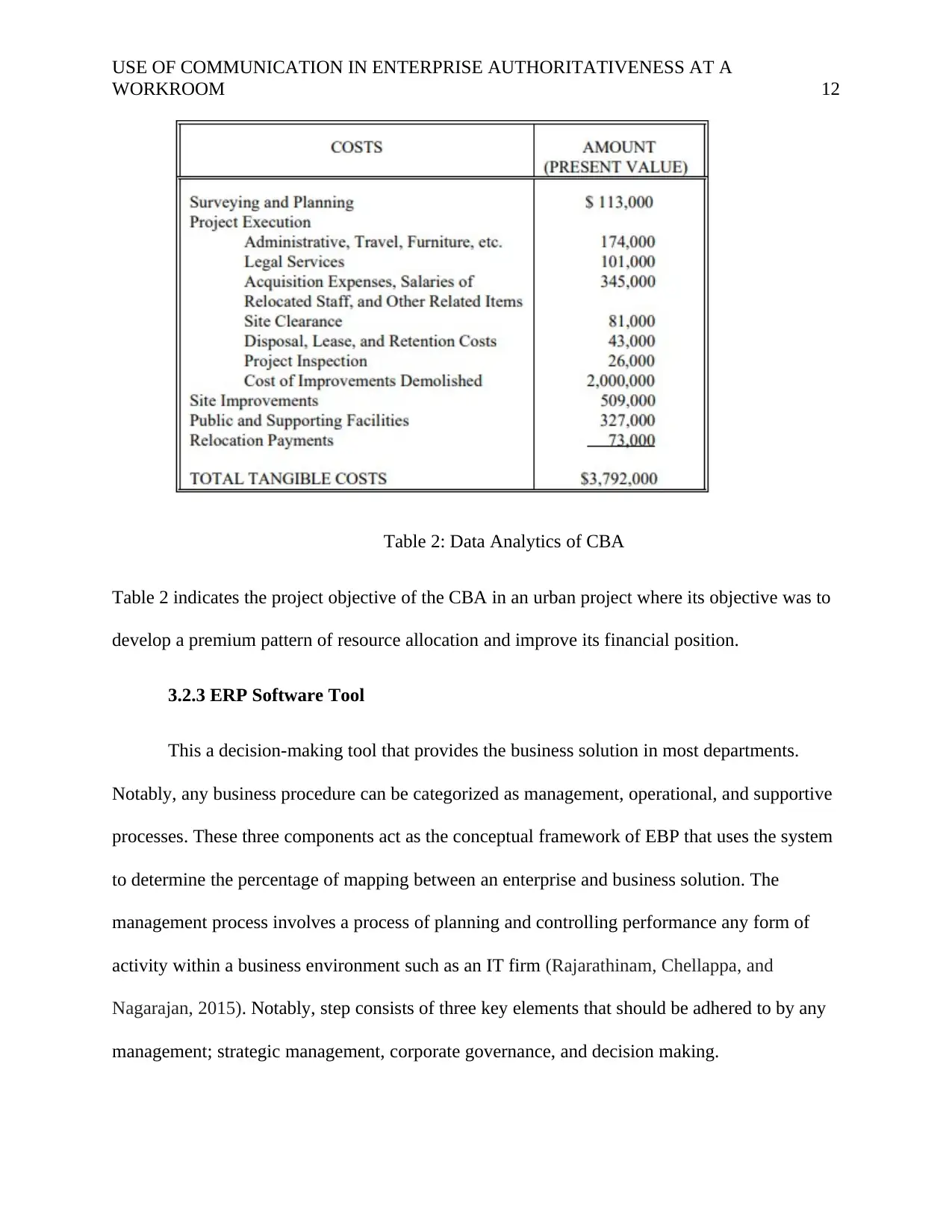
USE OF COMMUNICATION IN ENTERPRISE AUTHORITATIVENESS AT A
WORKROOM 12
Table 2: Data Analytics of CBA
Table 2 indicates the project objective of the CBA in an urban project where its objective was to
develop a premium pattern of resource allocation and improve its financial position.
3.2.3 ERP Software Tool
This a decision-making tool that provides the business solution in most departments.
Notably, any business procedure can be categorized as management, operational, and supportive
processes. These three components act as the conceptual framework of EBP that uses the system
to determine the percentage of mapping between an enterprise and business solution. The
management process involves a process of planning and controlling performance any form of
activity within a business environment such as an IT firm (Rajarathinam, Chellappa, and
Nagarajan, 2015). Notably, step consists of three key elements that should be adhered to by any
management; strategic management, corporate governance, and decision making.
WORKROOM 12
Table 2: Data Analytics of CBA
Table 2 indicates the project objective of the CBA in an urban project where its objective was to
develop a premium pattern of resource allocation and improve its financial position.
3.2.3 ERP Software Tool
This a decision-making tool that provides the business solution in most departments.
Notably, any business procedure can be categorized as management, operational, and supportive
processes. These three components act as the conceptual framework of EBP that uses the system
to determine the percentage of mapping between an enterprise and business solution. The
management process involves a process of planning and controlling performance any form of
activity within a business environment such as an IT firm (Rajarathinam, Chellappa, and
Nagarajan, 2015). Notably, step consists of three key elements that should be adhered to by any
management; strategic management, corporate governance, and decision making.
⊘ This is a preview!⊘
Do you want full access?
Subscribe today to unlock all pages.

Trusted by 1+ million students worldwide
1 out of 16
Related Documents
Your All-in-One AI-Powered Toolkit for Academic Success.
+13062052269
info@desklib.com
Available 24*7 on WhatsApp / Email
![[object Object]](/_next/static/media/star-bottom.7253800d.svg)
Unlock your academic potential
Copyright © 2020–2025 A2Z Services. All Rights Reserved. Developed and managed by ZUCOL.




